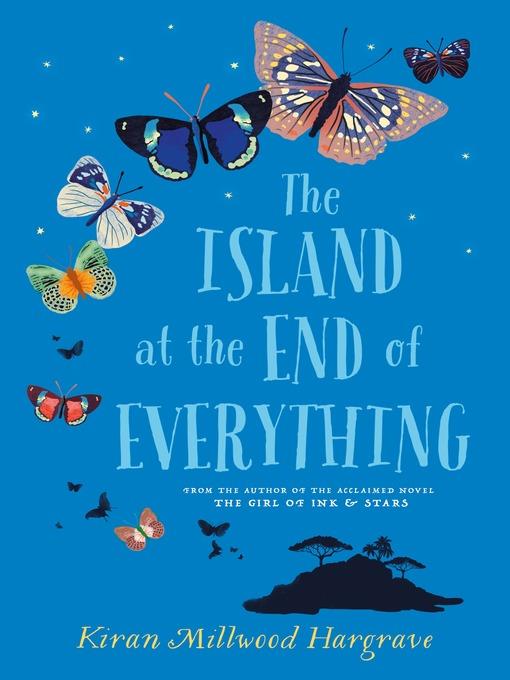
The Island at the End of Everything
فرمت کتاب
ebook
تاریخ انتشار
2018
Lexile Score
770
Reading Level
3-4
ATOS
5
Interest Level
4-8(MG)
نویسنده
Kiran Millwood Hargraveشابک
9780553535341
کتاب های مرتبط
- اطلاعات
- نقد و بررسی
- دیدگاه کاربران
نقد و بررسی

February 1, 2018
Life on an island for those with Hansen's disease is all Amihan has ever known. Now she must face the outside world, ostracized for living among the lepers.In 1906, Amihan's mother was taken from her home to live on Culion, an island leper colony in the Philippines. Isolated from the rest of the world, Amihan loves life on Culion, and caring for her mother and watching for butterflies is all she wants to do. Then an unexpected visitor from the department of health arrives and declares that healthy children will be taken to live in an orphanage on a nearby island, away from the disease but also separated from their families. There Amihan meets Mariposa, a girl named for the butterflies, and they become fast friends. When alarming news reaches her, Amihan is in dire need to see her mother, and together the girls journey to find their way back to Culion. Narrated in the present tense from Amihan's point of view, the writing, laced with Tagalog, is simple, but the themes and topics are heavy, such as being seen as less than human. For her second novel, Hargrave (The Cartographer's Daughter, 2016) researched the history of the real island of Culion, and in it she captures the raw feelings of stigma, exile, and loss that came with Hansen's disease at that time.A heartbreaking and heartwarming must-read about love, loss, friendship, and determination in times of desperation. (glossary, author's note) (Historical fiction. 9-12)
COPYRIGHT(2018) Kirkus Reviews, ALL RIGHTS RESERVED.

March 1, 2018
Gr 4-7-Amihan was born on the island of Culion in the Philippines, but most of the islands' residents were brought there after contracting leprosy. Ami's Nanay (mother) was sent there shortly after her diagnosis-she discovered she was pregnant upon arrival. Ami and her mother live a peaceful life for 12 years until the arrival of Mr. Zambora, a government official sent to remove all uninfected children. Ami and other uninfected children are sent to an orphanage on another island. When Ami learns her Nanay has taken a turn for the worse, she's desperate to get back and solicits the help of friend Mari. Ami's resilient voice is distinct and her story unique for a middle grade audience. Her first-person account of the inhuman and cruel treatment of those with leprosy is eye-opening. The novel is peppered with a handful of words in Tagalog, further pulling readers into Ami's world. Lushly described settings serve as a stark contrast to the harsh set of circumstances that she and the Culion children face. The novel is abundant with opportunities for classroom use; themes of empathy and resilience can be explored, as can the history of Culion, which was created as a leper colony in 1906. VERDICT This touching middle grade novel will attract a wide range of readers.-Juliet Morefield, Belmont Library, Portland, OR
Copyright 2018 School Library Journal, LLC Used with permission.

April 23, 2018
In 1906, 12-year-old Amihan lives with her mother on the Philippine island of Culion, which would become the largest leper colony in the world. Amihan and her mother share a tranquil life of quiet rituals, cooking fresh seafood, âcatchingâ falling stars at night, and trying to grow a garden for butterflies. Their small community of the healthy and the afflicted (the term âTouchedâ is preferred to âleperâ) live together peacefully until Mr. Zamora, a cruel government official, arrives to segregate the population and send âcleanâ children to an orphanage on a separate island. Amihan is heartbroken to leave her mother, whose disease is quite advanced, but once at the orphanage, she makes two friends who help her return when she gets word that her mother is dying. Hargraveâs lush, lyrical prose brings the jungle island to life and pulls readers into Amihanâs wrenching journey. Facts about the âTouchedâ contrast with peopleâs uninformed, fear-driven reactions, in particular those of Mr. Zamora, whose loathing of the afflicted leads to irrational and hateful behavior. A moving look at how prejudice blinds people to the humanity of others. Ages 10-up. Agent: Hellie Ogden, Janklow & Nesbit.

Starred review from February 1, 2018
Grades 4-8 *Starred Review* Hargrave transports readers to the Philippines' Culion Island, 1906, in her poetic and affecting historical novel. This picturesque spit of land once housed a leper colony, and it is there that 12-year-old Amihan's story unfolds. Though raised on Culion by her naynay (mother), who is touched with leprosy, Ami is perfectly healthy, due to their extreme mindfulness and sanitation practices. She attends a school run by nuns with the island's other children, but all that changes when Mr. Zamora arrives to enact a government order to eradicate the disease through segregation: We will make history of lepers, ' he says, and a museum of this island.' Cruel and prejudiced, he divides the island into Sano and Leproso zones, and takes all healthy children to the Coron Orphanage on a neighboring island. Ami's heart is broken when she is ripped away from her mother, but she makes her first friend, Mari, at the orphanage, and together they plot a way to return to Culion. Hargrave tells an incredible story of compassion, love, and daring in this book's pages, and her lyrical writing glides with the grace of a butterfly. An author's note gives the real history of Culion's leper colony and speaks to the complexity of human nature, further enriching Ami's unforgettable story.(Reprinted with permission of Booklist, copyright 2018, American Library Association.)

























دیدگاه کاربران